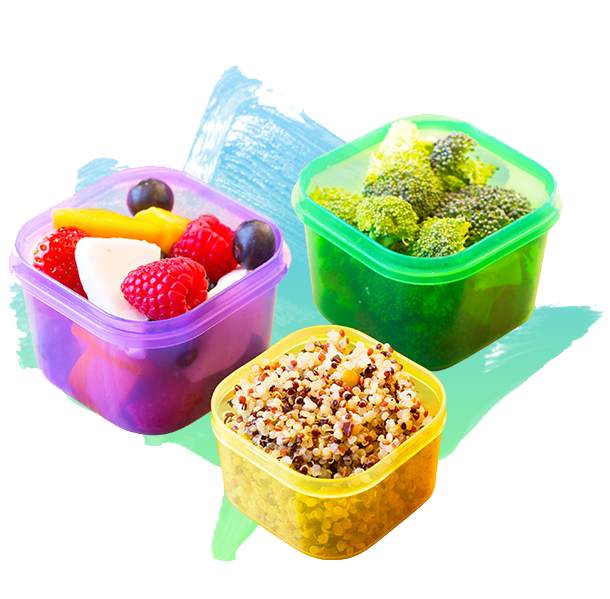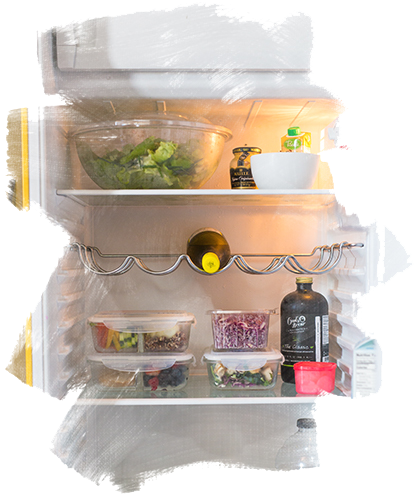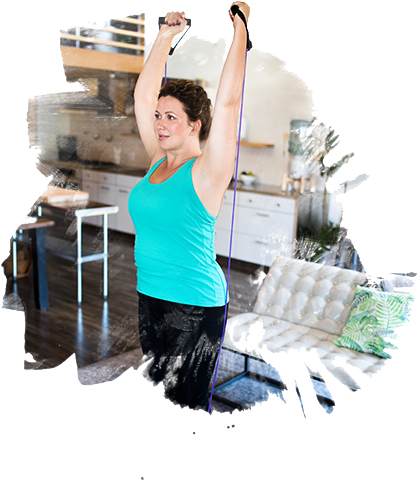How To Start
LOSING WEIGHT
Do you find that you go from inspired to apathetic in a matter of days when it comes to losing weight? This is the plight many of us face. We want to lose weight, but it’s easy to get overwhelmed.
Inspired to finally make a change, many of us end up following an all-or-nothing approach to weight loss that’s not sustainable. Research shows that having clear objectives is one of the best tools one can have when starting a weight-loss program. This means putting some work in on the front end of your journey in order to make way for the path of least resistance.
BODi’S ULTIMATE GUIDE TO WEIGHT LOSS: CHAPTER 2

How To Start
LOSING WEIGHT

BODi’S GUIDE TO WEIGHT LOSS: CHAPTER 2
Do you find that you go from inspired to apathetic in a matter of days when it comes to losing weight? This is the plight many of us face. We want to lose weight, but it’s easy to get overwhelmed.
Inspired to finally make a change, many of us end up following an all-or-nothing approach to weight loss that’s not sustainable. Research shows that having clear objectives is one of the best tools one can have when starting a weight-loss program. This means putting some work in on the front end of your journey in order to make way for the path of least resistance.
Being sensible about what to keep and what to toss from your pantry and consuming the correct portion sizes are a few of the moves you can make. You should also be sure to have comfortable workout clothes and footwear at the ready, and know how you’re going to track your progress. That might mean purchasing a scale, heart rate monitor, or body fat tester.
No matter what your objectives are, educating yourself and laying some groundwork, rather than blindly jumping in, can clear a path for success. Read on for no-nonsense advice on how to reach your goals.
Being sensible about what to keep and what to toss from your pantry and consuming the correct portion sizes are a few of the moves you can make. You should also be sure to have comfortable workout clothes and footwear at the ready, and know how you’re going to track your progress. That might mean purchasing a scale, heart rate monitor, or body fat tester.
No matter what your objectives are, educating yourself and laying some groundwork, rather than blindly jumping in, can clear a path for success. Read on for no-nonsense advice on how to reach your goals.
HOW TO
LOSE WEIGHT
Start with These 4 Steps
There’s no getting around the fact that we live in a fast-paced, competitive world. We are pretty much all guilty of taking on more than we should at times. We try to be superstar parents, spouses, and employees all at once. And we want our houses to be clean and our bodies to be in shape as well despite the fact that there are only 24 hours in a day.
What’s the first thing to fall to the wayside amidst this chaos? For most of us, it’s taking care of ourselves.
Finding time to take on something like weight loss can feel akin to preparing to climb Mount Everest. While it might not require you to withstand blizzards, avalanches, and 200-mile-per-hour freezing winds as you make your way to 29,000 feet, losing weight comes with its own set of considerable challenges.
Social media, magazines, and even your physician can all offer useful weight loss tips, but properly executing them is easier said than done. To be sure, you wouldn’t attempt to climb a mountain without some forethought and preparation. In the same way, laying out a detailed plan of attack for weight loss is essential to your success.
This plan should include everything from what and how much you’re going to eat, how you’re going to track your progress, and what gear you’ll need to make it all happen. Think of this as building your basecamp before pushing toward the summit. Read on for a breakdown of all the things you should consider to ensure a successful climb.

HOW
TO
LOSE
WEIGHT
Start with These 4 Steps
There’s no getting around the fact that we live in a fast-paced, competitive world. We are pretty much all guilty of taking on more than we should at times. We try to be superstar parents, spouses, and employees all at once. And we want our houses to be clean and our bodies to be in shape as well despite the fact that there are only 24 hours in a day.
What’s the first thing to fall to the wayside amidst this chaos? For most of us, it’s taking care of ourselves.
Finding time to take on something like weight loss can feel akin to preparing to climb Mount Everest. While it might not require you to withstand blizzards, avalanches, and 200-mile-per-hour freezing winds as you make your way to 29,000 feet, losing weight comes with its own set of considerable challenges.
Social media, magazines, and even your physician can all offer useful weight loss tips, but properly executing them is easier said than done. To be sure, you wouldn’t attempt to climb a mountain without some forethought and preparation. In the same way, laying out a detailed plan of attack for weight loss is essential to your success.
This plan should include everything from what and how much you’re going to eat, how you’re going to track your progress, and what gear you’ll need to make it all happen. Think of this as building your basecamp before pushing toward the summit. Read on for a breakdown of all the things you should consider to ensure a successful climb.
Determine daily
calorie intake
Pinning down how many calories you should consume is half the battle when you consider the fact that all calories aren’t created equal. Unfortunately, 500 calories of deep-fried cheese curds is not equivalent to 500 calories of raw vegetables. That’s why figuring out what your macros, a.k.a. macronutrient intake, should be similarly important.
Macros include protein, carbohydrates, and fats. While tracking the rough percentage of daily calories you get from each macronutrient group takes a bit more planning than simply determining how many calories you should take in to maintain health and lose weight, it gives you more direction on what exactly to eat.
To determine your daily caloric needs for weight loss, consult the BODi program guide, available on BODi, which will walk you through a (simple) mathematical equation to determine your daily calorie range for weight loss.

Once you’ve crunched the numbers, consider getting your hands on BODi’s Portion Fix Containers to take the guess work out of how much of each macronutrient you should eat each day to lose weight. Instead of weighing your food or constantly counting the grams of carbs, protein, and fat listed on nutrition labels, simply pop your food into these containers before plating your meal, and you’re good to go. You can follow the BODi Portion Fix Eating Plan, which outlines how many macros you can have each day, or follow the nutrition plans that accompany the BODi program you choose.
The Portion Fix Eating Plan includes tally sheets for you to keep track of how many containers of each type (carbs, protein, fats) you’ve eaten. Another option is to download one of the many nutrition apps that can help you track your intake. Why track your calories and macros? Research has shown that people who kept a food diary lost nearly twice as much weight as people who didn’t.
Before you start a new diet, it can also be helpful to track your current eating habits for two weeks so that you can spot any unhealthy trends. Maybe you’ve been slamming an extra sugary coffee drink or indulging in dessert after dinner more days of the week than you even realized. Identifying the things you need to change gives you direction as you decide on a diet plan that will work for you.

Determine daily
calorie intake
Pinning down how many calories you should consume is half the battle when you consider the fact that all calories aren’t created equal. Unfortunately, 500 calories of deep-fried cheese curds is not equivalent to 500 calories of raw vegetables. That’s why figuring out what your macros, a.k.a. macronutrient intake, should be similarly important.
Macros include protein, carbohydrates, and fats. While tracking the rough percentage of daily calories you get from each macronutrient group takes a bit more planning than simply determining how many calories you should take in to maintain health and lose weight, it gives you more direction on what exactly to eat.
To determine your daily caloric needs for weight loss, consult the BODi program guide, available on BODi, which will walk you through a (simple) mathematical equation to determine your daily calorie range for weight loss.
Once you’ve crunched the numbers, consider getting your hands on BODi’s Portion Fix Containers to take the guess work out of how much of each macronutrient you should eat each day to lose weight. Instead of weighing your food or constantly counting the grams of carbs, protein, and fat listed on nutrition labels, simply pop your food into these containers before plating your meal, and you’re good to go. You can follow the BODi Portion Fix Eating Plan, which outlines how many macros you can have each day, or follow the nutrition plans that accompany the BODi program you choose.
The Portion Fix Eating Plan includes tally sheets for you to keep track of how many containers of each type (carbs, protein, fats) you’ve eaten. Another option is to download one of the many nutrition apps that can help you track your intake. Why track your calories and macros? Research has shown that people who kept a food diary lost nearly twice as much weight as people who didn’t.
Before you start a new diet, it can also be helpful to track your current eating habits for two weeks so that you can spot any unhealthy trends. Maybe you’ve been slamming an extra sugary coffee drink or indulging in dessert after dinner more days of the week than you even realized. Identifying the things you need to change gives you direction as you decide on a diet plan that will work for you.

Track Your Progress
There’s a good reason one of the most oft-cited weight loss tips involves tracking your progress. When we see real, tangible movement in the direction of our goals, we tend to be more motivated to keep putting in the work necessary to achieve them. While it’s unhealthy to obsess over how much and how fast you’re losing weight, setting some benchmarks can be helpful.
There are countless ways to monitor your weight loss. This might mean weighing yourself regularly or taking your measurements at predictable intervals. It could also involve a pair of skinny jeans, a wedding dress, or another garment that you are hoping to fit into once you shed the pounds.
Beachbody Super Trainer Leandro Carvalho, creator of YOUv2, a four-week dance and sculpting routine set to hits from the ’80s and designed for those new to exercise, also suggests taking measurements of your waist, hips, legs, arms, and chest as a way to keep track of your weight-loss progress.
“If you see over time that you’ve lost some weight or you’ve lost some inches, that’s big motivation. And sometimes you don’t notice this happening as much because you lose weight little by little,” says Carvalho.
Whatever method you choose, make sure it motivates you. Decide how often you’ll weigh yourself or try on your jeans (maybe once a week), and keep a detailed log. Also keep in mind that real progress comes from putting in the effort to eat clean and exercise over a sustained period of time, so don’t get discouraged if you don’t see instant results. As they say, “a watched pot never boils.”

Track Your Progress
There’s a good reason one of the most oft-cited weight loss tips involves tracking your progress. When we see real, tangible movement in the direction of our goals, we tend to be more motivated to keep putting in the work necessary to achieve them. While it’s unhealthy to obsess over how much and how fast you’re losing weight, setting some benchmarks can be helpful.
There are countless ways to monitor your weight loss. This might mean weighing yourself regularly or taking your measurements at predictable intervals. It could also involve a pair of skinny jeans, a wedding dress, or another garment that you are hoping to fit into once you shed the pounds.
BODi Super Trainer Leandro Carvalho, creator of YOUv2, a four-week dance and sculpting routine set to hits from the ’80s and designed for those new to exercise, also suggests taking measurements of your waist, hips, legs, arms, and chest as a way to keep track of your weight-loss progress.
“If you see over time that you’ve lost some weight or you’ve lost some inches, that’s big motivation. And sometimes you don’t notice this happening as much because you lose weight little by little,” says Carvalho.
Whatever method you choose, make sure it motivates you. Decide how often you’ll weigh yourself or try on your jeans (maybe once a week), and keep a detailed log. Also keep in mind that real progress comes from putting in the effort to eat clean and exercise over a sustained period of time, so don’t get discouraged if you don’t see instant results. As they say, “a watched pot never boils.”
Get organized
Once you’ve defined the dietary changes you want to make, along with how you plan on tracking your progress, take stock of whether you have all the proper tools to execute your plan. Here’s a list of things you might find helpful when starting your weight-loss journey:
- BODi all-access pass
- Smartphone apps
- Portion containers
- Scale or body fat tester
- Healthy cooking tools: blender, slow cooker, salad spinner, measuring spoons
- Clean eating recipes
- At-home workout gear: resistance bands, exercise mat, dumbbells of various weights

Removing temptation foods from your refrigerator and pantry and replacing them with a good stock of healthy options is another essential step to complete before you start your new eating plan. While many weight loss tips you’ve likely read often include advice on self-control, why be tempted in the first place? Pitch the unhealthy stuff and stock up on healthier foods so you don’t go astray in a hangry moment.
In addition to the exercise gear listed above, be sure you have the clothes and shoes you’ll need to exercise regularly. Research shows that clothing can impact the wearer’s psychology by impacting the way he or she performs while wearing the items. You’ll likely feel more competent and confident in workout clothes that are comfortable and fit properly. No, you don’t need a drawer full of overpriced nylon and polyester to exercise. But, if you’re wearing 10-year old shoes and old cotton sweats with holes in them, treat yourself to a new ensemble.

Get organized
Once you’ve defined the dietary changes you want to make, along with how you plan on tracking your progress, take stock of whether you have all the proper tools to execute your plan. Here’s a list of things you might find helpful when starting your weight-loss journey:
- BODi all-access pass
- Smartphone apps
- Portion containers
- Scale or body fat tester
- Healthy cooking tools: blender, slow cooker, salad spinner, measuring spoons
- Clean eating recipes
- At-home workout gear: resistance bands, exercise mat, dumbbells of various weights
Removing temptation foods from your refrigerator and pantry and replacing them with a good stock of healthy options is another essential step to complete before you start your new eating plan. While many weight loss tips you’ve likely read often include advice on self-control, why be tempted in the first place? Pitch the unhealthy stuff and stock up on healthier foods so you don’t go astray in a hangry moment.
In addition to the exercise gear listed above, be sure you have the clothes and shoes you’ll need to exercise regularly. Research shows that clothing can impact the wearer’s psychology by impacting the way he or she performs while wearing the items. You’ll likely feel more competent and confident in workout clothes that are comfortable and fit properly. No, you don’t need a drawer full of overpriced nylon and polyester to exercise. But, if you’re wearing 10-year old shoes and old cotton sweats with holes in them, treat yourself to a new ensemble.

Set your goals
As was previously suggested, trying to muscle up the mountain in one go is a recipe for failure. Conversely, taking a measured and patient approach sets you up to achieve your long-term goals. As such, take a moment to write down one or two unhealthy behaviors you want to eliminate this week, and one or two you want to eliminate next week. This is a great way to ease into your first moves up the mountain.
While it may seem like a long journey to make, getting started is often the most challenging part.

Set your goals
As was previously suggested, trying to muscle up the mountain in one go is a recipe for failure. Conversely, taking a measured and patient approach sets you up to achieve your long-term goals. As such, take a moment to write down one or two unhealthy behaviors you want to eliminate this week, and one or two you want to eliminate next week. This is a great way to ease into your first moves up the mountain.
While it may seem like a long journey to make, getting started is often the most challenging part.


